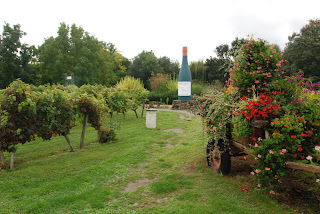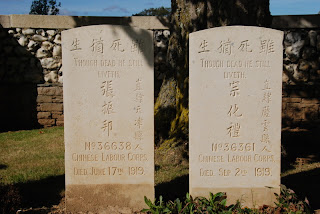The weather has been very unsettled
over the past few days, warm, especially at night, with a mixture of
light rain, sharp showers and bright, hot sunshine. Last night was
especially warm with the outside temperature at 07:00 this morning,
just before dawn, being 17°C.
We arrived at the Tumulus of Bourgon at
10:00 when it opened and started our visit by walking to the
collection of five tumuli. On the way we passed excellent
installations showing the latest ideas as to how the tumuli were
constructed. Four stages had been reconstructed showing the placing
of the initial stones for the wall of the burial chamber; placing the
large capstone on the chamber; the completed tumulus prior to it
being covered by the mound; the dolmen of today – the tumulus after
the effects of erosion and human activity over the millennia.
We then passed a reconstruction of an
enormous 3rd millennium BC communal thatched building
before we arrived at the cemetery. The tumuli were intriguing –
different shapes and sizes, reused in different periods and then
there was an enigmatic low bank (a tumulus without burials?) that
separated the cemetery into two parts. It was possible to enter the
burial chambers of most of the tumuli – some had more than one. The
tumuli date from approx. 4700 to 3500 BC, a period of nearly 2,000
years. This makes it one of the most ancient and important example of
funerary architecture in the world.
Many tumuli in England were plundered
in Victorian times when it became fashionable for land owners to take
their family and friends to these ancient cemeteries and, while the
family enjoyed a picnic, the workers dug down through the centre of
the tumuli to find the burial at the centre. This was generally done
in a very unscientific manner, so no records were kept and the finds
lost. At Bourgon however it was different. Initially investigated by
interested amateurs in 1840, it was purchased by the local authority
in 1873 to ensure that it was protected for the future. They have
done a very good job!
On the way back to the museum we passed
an installation showing ideas of how megaliths were moved by the
ancients. Experimental archaeology was performed using a 32 tonne
block and logs. It took 200 people to pull the bock over the logs but
when levers were used to turn the logs under the block (there is no
evidence that the ancients used this technique), they were able to
move the block with just 15 people.
We had been provided with an English
language audio guide that was extremely useful as we went around the
external exhibits and it also covered the museum exhibits. There were
extensive exhibits on general prehistoric archaeology, specific sites
in France and world-wide, films (our audio guide gave us real-time
translations to the commentary), and finds from the Bourgon site. It
was very good, the only niggle being that there was very little audio
commentary about the Bourgon finds.
We had spent nearly three hours at
Bourgon and were very glad that we had decided to come back today.
We drove on to the ravine that we
intended to visit yesterday, Puits d'Enfer (The Well of Hell). When
we arrived at this popular beauty spot it started to pour with rain –
we decided that we weren't that keen to see a small waterfall in a
gorge!
Next on the list was the Gallo-Roman
remains near Sanxay (Ruines Gallo-Roman d'Herbord). An umbrella was
required as it was drizzling at times but we went to inspect the
theatre, baths and temple. We have seen a few Roman theatres and this
one was fairly run-of-the-mill but the baths and temple were
impressive. We found out later from the curator that this is one of
the best preserved Roman bathhouses in France. Walls stood to a great
height and it was easy to see the construction of the different pools
– Roman concrete supported remnants of the flooring that clearly
showed the imprint of the tiles that lined the pools. In the hot
pools, this floor was suspended 1.5 metres above the ground surface.
This is where columns would have supported the pool allowing the hot
air from the furnaces to circulate and heat the water above.
The temple complex consists of a large
open area surrounded by a colonnaded terrace and with a 1st
Century BC temple at its centre. This is of Celtic design and is
thought to have been built over an earlier Gaulish shrine. Four arms
protrude from the octagonal centre below which there is a sacred
spring. The Romans adopted the site (they liked to convert existing
religious sites) and dedicated the temple to Apollo and Mercury. It
appears to have become an important site for the Romans who came to
be cured by its therapeutic waters.
Jane had spotted an aire in the 'All
the Aires of France' book that said Vasles was a “sheep village;
lots of items celebrating sheep”. We were both intrigued by this
and many miles away we saw road signs directing the way to 'Vasles –
Mouton Village'. We decided to make that our overnight stop.
I must say that it was disappointing.
The aire was good but the town is uninteresting unless you want to
visit the Mouton Village that has sheep from all around the world,
including Scotland but, strangely, not Wales.
Photos: Bourgon - Building a tumulus,
here showing how the walls of the burial chamber were constructed;
Tumulus F at Bourgon that has three separate burial chambers; Inside
the burial chamber of Tumulus A; The Roman Temple at Sanxay.








































